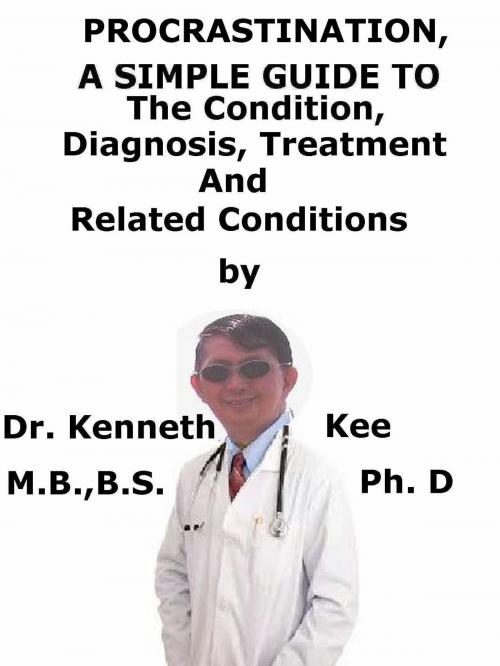Procrastination, A Simple Guide To The Condition, Diagnosis, Treatment And Related Conditions
Nonfiction, Health & Well Being, Psychology, Clinical Psychology| Author: | Kenneth Kee | ISBN: | 9780463531914 |
| Publisher: | Kenneth Kee | Publication: | August 14, 2018 |
| Imprint: | Smashwords Edition | Language: | English |
| Author: | Kenneth Kee |
| ISBN: | 9780463531914 |
| Publisher: | Kenneth Kee |
| Publication: | August 14, 2018 |
| Imprint: | Smashwords Edition |
| Language: | English |
This book describes Procrastination, Diagnosis and Treatment and Related DiseasesProcrastination is not an easy subject to write about because the tendency to procrastinate writing about procrastination is very high in my own case.
It is not an easy topic to write about since writers tend to procrastinate unless they have a rigid formula to use.
I will be writing about procrastination in the best way I know how:
- Definition and description
2, Causes - Symptoms
- Treatment
- Conclusion or Prognosis
Believe it or not, this is one book that I do not wish to procrastinate because of its title.
Some how or other what normally takes me a few days turn into weeks.
Finally I have finished the final draft.
Procrastination is the action of delaying or postponing a task or collection of tasks.
People have been struggling with delaying, avoiding, and procrastinating on things that matter to them, even for centuries.
Procrastination is so timeless that ancient Greek philosophers like Socrates and Aristotle had a word to portray this form of behavior: Akrasia.
Akrasia is considered as the lack of self-control or the state of working against a person’s better judgment.
It occurs when a person does one thing even though that person knows he or she should do something more important.
- Procrastination is a psychological disorder that all people come in contact at one period or another.
Occasionally when people temporarily decide not to procrastinate, they feel satisfied and productive.
They should attempt to make those rare occasions of productivity more common.
Procrastination is so easy to do: - Laze around doing nothing
- Watching television or better still,
- Watching life pass by minute by minute
- Read a book or use the computer or smartphone for trivial social information
The things people procrastinate tend to be boring, hard, time-consuming, or maybe they lack meaning to them.
Cause:
- A Fear of Failure
2: Perfectionism - Excessive Perfectionism
- Low Energy Levels
- A Lack of Focus
6: Fear of the Unknown
7: The Person Will Do It Later
8: Working on Small Tasks Because They are Easier
9: The Person Experiences a Lack of Motivation
10: The Person Is Unclear About How to Get Started
11: The Person Often Gets Distracted
12: The Person Know the Task Will Require Effort and Hard Work
Symptoms:
Procrastination is a long word for this fast idea: doing later
- Lack of Vision
- Lack of Time
- Lack of Organization
- Tiredness
- Fear
- Easily distracted
- Feeling Overwhelmed
Diagnosis:
- The person gets up late
- Every time is the bed time
- The person is getting addictive
- When it is too hard, the person gives up
- The person no longer trusts himself
- The person envies hard workers
- The life is in a predictable loop
- The Last time the person hits the gym was 2 decades ago
- The friends always complain
- The person is always in a hurry
- The person has a messy room/workplace
- The person is easily stressed
- The person thinks “meditation” is a new shampoo
- Planning is something the person can only find in Hunger Games
- The person is waking up when it comes to deadlines
and 22 more diagnostic features
Treatment:
De-clutter the desk
De-clutter digitally
No internet or notifications
1 program only
Use simple tools like pen and paper or Notepad
Single tasking
Start small
Break large task to tiny ones
Give a reward
Do the next task
Take baby steps
Make rewards of not procrastinating instant
Make the Task More Achievable
Being Consistent
Visual cues
Start with the hardest task
Pace the mind
Keep a To-Do List
Set goals
Time travel to finish line - This is the best!
TABLE OF CONTENT
Introduction
Chapter 1 Procrastination
Chapter 2 Causes
Chapter 3 Symptoms
Chapter 4 Diagnosis
Chapter 5 Treatment
Chapter 6 Prognosis
Chapter 7 Rational Emotive Behavior Therapy
Chapter 8 Akrasia
Epilogue
This book describes Procrastination, Diagnosis and Treatment and Related DiseasesProcrastination is not an easy subject to write about because the tendency to procrastinate writing about procrastination is very high in my own case.
It is not an easy topic to write about since writers tend to procrastinate unless they have a rigid formula to use.
I will be writing about procrastination in the best way I know how:
- Definition and description
2, Causes - Symptoms
- Treatment
- Conclusion or Prognosis
Believe it or not, this is one book that I do not wish to procrastinate because of its title.
Some how or other what normally takes me a few days turn into weeks.
Finally I have finished the final draft.
Procrastination is the action of delaying or postponing a task or collection of tasks.
People have been struggling with delaying, avoiding, and procrastinating on things that matter to them, even for centuries.
Procrastination is so timeless that ancient Greek philosophers like Socrates and Aristotle had a word to portray this form of behavior: Akrasia.
Akrasia is considered as the lack of self-control or the state of working against a person’s better judgment.
It occurs when a person does one thing even though that person knows he or she should do something more important.
- Procrastination is a psychological disorder that all people come in contact at one period or another.
Occasionally when people temporarily decide not to procrastinate, they feel satisfied and productive.
They should attempt to make those rare occasions of productivity more common.
Procrastination is so easy to do: - Laze around doing nothing
- Watching television or better still,
- Watching life pass by minute by minute
- Read a book or use the computer or smartphone for trivial social information
The things people procrastinate tend to be boring, hard, time-consuming, or maybe they lack meaning to them.
Cause:
- A Fear of Failure
2: Perfectionism - Excessive Perfectionism
- Low Energy Levels
- A Lack of Focus
6: Fear of the Unknown
7: The Person Will Do It Later
8: Working on Small Tasks Because They are Easier
9: The Person Experiences a Lack of Motivation
10: The Person Is Unclear About How to Get Started
11: The Person Often Gets Distracted
12: The Person Know the Task Will Require Effort and Hard Work
Symptoms:
Procrastination is a long word for this fast idea: doing later
- Lack of Vision
- Lack of Time
- Lack of Organization
- Tiredness
- Fear
- Easily distracted
- Feeling Overwhelmed
Diagnosis:
- The person gets up late
- Every time is the bed time
- The person is getting addictive
- When it is too hard, the person gives up
- The person no longer trusts himself
- The person envies hard workers
- The life is in a predictable loop
- The Last time the person hits the gym was 2 decades ago
- The friends always complain
- The person is always in a hurry
- The person has a messy room/workplace
- The person is easily stressed
- The person thinks “meditation” is a new shampoo
- Planning is something the person can only find in Hunger Games
- The person is waking up when it comes to deadlines
and 22 more diagnostic features
Treatment:
De-clutter the desk
De-clutter digitally
No internet or notifications
1 program only
Use simple tools like pen and paper or Notepad
Single tasking
Start small
Break large task to tiny ones
Give a reward
Do the next task
Take baby steps
Make rewards of not procrastinating instant
Make the Task More Achievable
Being Consistent
Visual cues
Start with the hardest task
Pace the mind
Keep a To-Do List
Set goals
Time travel to finish line - This is the best!
TABLE OF CONTENT
Introduction
Chapter 1 Procrastination
Chapter 2 Causes
Chapter 3 Symptoms
Chapter 4 Diagnosis
Chapter 5 Treatment
Chapter 6 Prognosis
Chapter 7 Rational Emotive Behavior Therapy
Chapter 8 Akrasia
Epilogue















